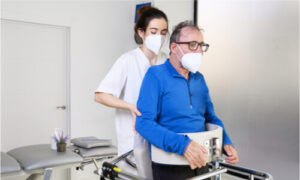Do ALS symptoms come and go? Aside from that, how should we react when we observe ALS symptoms? In actuality, diagnosis of ALS may take about an average of nine to 12 months. For this reason, it would be best to have your physician regularly check your health condition. Your annual check-ups ensure your health is well monitored. This way, you can prevent the progression of any health disease.
Amyotrophic lateral sclerosis (ALS)
This health condition involves the destruction of nerve cells that controls voluntary muscle movement. These voluntary muscle movements include chewing, walking, talking, breathing, and many more.
Some people refer to ALS as Lou Gehrig’s disease, from the name of the baseball player who had this health condition. In actuality, doctors usually don’t know why ALS occurs, while the others inherit this condition.
This disease causes gradual damage to the body’s motor neurons. As time passes by, these motor neurons will start to die gradually. As a result, transferring the message from the brain and spinal cord to the muscles also dies.
In this situation, the person who has this disease will not be able to use the muscles. In effect, the muscles will become weak, twitch (fasciculations), or continuously break down (atrophy). On the negative side, there is no cure for ALS. However, treatments are still available.
On the other hand, an individual diagnosed with this disease will have a short lifespan and can even die a few years after the diagnosis. Below is a short video that explains how doctors diagnose this progressive disease.
ALS symptoms
Every individual can have different symptoms. These variations depend on which neurons that the disease particularly affected. However, being familiar with these symptoms will help you act on them at the soonest possible time.
 You experience difficulties in performing daily activities, such as walking.
You experience difficulties in performing daily activities, such as walking.- Moreover, you encounter tripping and falling.
- With this disease, you feel weakness in your leg, feet, or ankles.
- You also have difficulties controlling your hand movements, such as grasping.
- Additionally, you also have trouble in your speech and swallowing the food you eat.
- Furthermore, you can even experience muscle cramps and twitching.
- There are even instances wherein you cry, laugh, or yawn inappropriately.
- Lastly, you will also observe sudden cognitive and behavioural changes.
Generally speaking, ALS incorporates significant physical impairment. It often starts with your hands then completely spread to other parts of your body.
Stages of ALS
ALS progression falls under three stages, distinctively. Each level varies in the symptoms the disease show. Let us discover the essential facts we need to know about these stages of ALS.
- Early stages of ALS: At this level, a person with this disease experiences muscle weakness, spasticity, crampings, or fasciculations. Besides that, muscle loss or atrophy is also significant at this level. During the early stages of ALS, the patient will start to encounter difficulty with the usual tasks they do, such as buttoning clothes or opening a can good. Besides that, ALS can cause fatigue, imbalance, speech issues, loss of grip strength, or tripping or falling during the early stages. It is a good idea to consult an eye doctor in case your vision gets blurry at this stage.
- The middle stage of ALS: At this stage, muscle weakness and atrophy in the early stages will spread out to other parts of the body. It is also at this stage wherein the patient can encounter a few muscle paralysis. Moreover, other muscles will continue losing their strength. The patient will also start to show inappropriate laughing or crying at this stage, which you can also call the pseudobulbar affect.
- Late-stage ALS: The continuous progression of the disease can lead to the complete paralysis of the voluntary muscles. Relative to this paralysis, the mouth and tongue are not an exemption. When this happens, the patient will start to experience difficulties in eating, speaking, and breathing. For this reason, the only option to eat and drink is through a feeding tube. As for the breathing concerns, the patient will be using a ventilator.
In general, most of the deaths from this disease are due to respiratory failures. Additionally, some patients may also experience problems with memory and decision-making in the long run. It can even lead to the risk of developing dementia.
Do ALS symptoms come and go?
Unfortunately, this neurological disease is a progressive type. It only means that ALS symptoms tend to become worse as time passes by. Moreover, it can develop very rapidly. ALS is debilitating, which means it leads to paralysis and death.
Researchers are continually studying data about ALS occurrences. This study aims to discover the possible causes of ALS. Initially, the theories usually lead to complex interactions between genetic and environmental factors.
With that said, below are the risk factors that increases the development of ALS.
- Heredity: A person can inherit ALS. In a situation wherein there are familial ALS, any of their children will have a 50-50 chance to develop ALS in the end.
- Age: When a person reaches 40, the risk is also increasing to develop ALS. The risk of developing ALS usually happens between 40 years old and mid-60s.
- Gender: Before reaching 65 years old, most men develop ALS compared to women. On the other hand, this gender distinction will change after reaching 70 years old.
- Genetics: Some studies show genetic variations that increase the susceptibility of developing ALS.
Aside from the factors we already mentioned, there are also environmental factors that can trigger ALS occurrence in a person.
- Smoking: In general, this lifestyle habit does not bring any good at all. In this case, women who are already at their menopausal stage are at high risk of developing ALS due to this environmental factor.
- High toxin exposure: Too much exposure to environmental chemicals can also increase the risk of developing ALS.
- Military service: Studies show that being in service for the military also contributes to ALS development. There is a high possibility of exposure to chemicals or metals, traumatic injuries, infections, and intense exertion.
Treatment for ALS
ALS is progressive, and as we mentioned, there is no cure for this disease. On the other hand, there is still treatment available for it. The only thing you should know is that this treatment only lightens up the symptoms.
 Physical therapy
Physical therapy- Occupational therapy
- Breathing therapy
- Speech therapy
- Nutritional support
- Prescription medications
However, for the question “do ALS symptoms come and go?” our answer would be, “it progresses”, and no cure is available. Only a relief to your symptoms.
Tips when battling ALS
Battling ALS will be a tough one for the patient and their family members. During this time, being knowledgeable about the disease is essential. They will play a vital role to assist the patient throughout the patient’s battle.
For the most part, communication will be difficult as ALS affects breathing, speech, and muscle movements. For this reason, the family members and friends should pour their love and patience into supporting the ALS patient.
Overall, the ALS journey is pretty challenging both for the patient and the family members. They should start planning to prepare for what can happen sooner or later. Moreover, they should seek sources for financial help as treatment will become expensive in the long run.
ALS is a battle you should learn how to cope up with. The only truth you can acknowledge is acceptance.





